The number of elements in the periodic table in car types: ICV, hybrid and plug in hybrid. [View all]
The paper I'll discuss in this post is this one: Characterizing the Changes in Material Use due to Vehicle Electrification (Karan Bhuwalka, Frank R. Field, Robert D. De Kleine, Hyung Chul Kim, Timothy J. Wallington, and Randolph E. Kirchain, Environmental Science & Technology 2021 55 (14), 10097-10107)
One of the ideas about which I've radically changed my mind in this century has to do with considering the purpose of energy efficiency. As the 20th century closed, I was still attached to the rhetoric, advanced by the tiresome fool Amory Lovins, that the purpose of achieving energy efficiency was to reduce the amount of energy consumed by humanity.
Not long into the 21st century, as I expanded my understanding I changed my mind, inasmuch as I now believe that the purpose of efficiency is not to reduce the amount of energy used, but rather to increase the use of energy with the important caveat that while increasing the use of energy, we also need to reduce its environmental impact of the entire energy system in comparison to that observed in the last 50 years. That means producing more energy while reducing the environmental impact.
Note that am not speaking of the more limited term "energy efficiency," but simply "efficiency," an important point relevant to this discussion.
First, about increasing the use of energy: It is clear, if not to everyone at least to me, that too many people lack access to energy, and that poverty is destructive to the environment, and finally that to restore what can be restored, and to save what can be saved, truly prodigious amounts of energy, more energy that the already prodigious amounts currently will be required. It is a thermodynamic fact that to remove carbon dioxide from the air - direct air capture or DAC, increasingly discussed in the scientific literature with a growing sense of desperation coupled with a healthy dollop of wishful thinking - one must generate all of the energy produced that put the carbon dioxide there in the first place, and then some, owing to entropy. This is seldom discussed, but it is a fact.
Facts matter.
Most of the carbon dioxide dumped by humanity in the last 150 years, with rates of dumping accelerating to obscene levels in the last 50 years derives from fossil fuels. This carbon dioxide was fixed, via the mechanism of photosynthesis, over hundreds of millions years, not a century and a half . One hears drivel all the time comparing the world industrial energy supply with the solar flux, insipid comments about how if we made the Sahara Desert, or Arizona, or some other vast geographical feature that we consider expendable, we could solve all our energy problems. This ignores the fact that the big advantage that photosynthesis has over solar cells is that biomass is self-replicating and, irrespective of the climate impacts of land use changes over the last 50 years, biomass once covered almost the entire land mass of the planet, and also functioned over vast areas of the oceans.
It still took hundreds of millions of years to fix all the carbon we've dumped in the much shorter period of 150 years.
Why this isn't obvious escapes me.
While we've all engaged in a reactionary fantasy about how so called "renewable energy" would save the day in this century - it didn't save the day, it isn't saving the day and it won't save the day - the quantities of carbon dioxide release by humanity have steadily increased from year to year. Now, including land use changes, climate related fires, and the continued and growing reliance on dangerous fossil fuels, we are releasing roughly 45 billion tons of carbon dioxide per year, along with large amounts of methane, long lived halocarbons, and sundry inorganic species, the most serious of which is nitrous oxide, "laughing gas" that is no laughing matter, as well as other nitrogen oxides and stuff like sulfur hexafluoride. (Sulfur oxides, notably sulfur trioxide and its hydrate, sulfuric acid, actually mitigate climate change by reducing the solar flux, at the obvious disadvantage of killing living things, including, but not limited to human beings.)
Early in this century, a poorly educated journalist named James Kunstler wrote a book, The Long Emergency which claimed that the depletion of petroleum would lead to a collapse of industrial civilization. This argument enjoyed not inconsiderable popularity and in fact led to the creation a cult of energy concern known as the "Peak Oil" movement, which has of late more or less petered out. Inasmuch as he drew attention to the role that petroleum plays in our culture, and to the fact that it is limited, he did manage to inspire considerable fear and angst that "something" had to be done to save the car CULTure, with which Americans, Europeans, and wealthy Asian nations live. (I must confess that even I took Kunstler seriously briefly, although I have educated myself out of embracing any such seriousness with which I took him.)
One thing that was done in the brief paroxysm of fear built around "peak oil" was to employ ever more extreme efforts to obtain oil, all of which were even more destructive to the future that previous methods of obtaining oil. Another, advanced by a highly educated writer, the fool Joe Romm, who for a time worked for the poorly educated fool Amory Lovins (and then briefly Bill Clinton) was that so called "renewable energy" and energy conservation would be sufficient to maintain an industrialized life style in the US. Rather than engaging the principle that experiment trumps theory, requisite for good science, Romm embraced Lovins' silly speculations - they were and are speculations rather than strictly theory in the scientific understanding of what theory is - since they are not based on any observed data or serious mathematical modeling.
By contrast, a theory that was based on observation was that of the 19th century economist William Jevons, the famous "Jevons Paradox," which was that increases in energy efficiency led to increases in energy consumption. Jevons theory was based on the observation that the development of the Watt Steam Engine, which displaced the earlier Newcombe steam engine because of its higher efficiency, lead to increases in the use of coal, not decreases. Interestingly 19th century concerns about "peak coal" in Great Britain motivated Jevons analysis: It was published in a book with a Kunstler sounding title called "The Coal Question; An Inquiry Concerning the Progress of the Nation, and the Probable Exhaustion of Our Coal Mines.". It is not my intention to insult the very real legacy of William Jevons by comparing him to little Jimmy Kunstler. Again, Jevons theory was based on observation rather than speculation, whereas the speculations of Kunstler, Romm, Lovins et al., are merely speculations, in many ways involved in tiresome dogma, irrational fear, and outright ignorance, and they are all faith based suppositions.
Another point has to be made, particularly with respect to Lovins: These speculations are highly nationalistic and culturally myopic and consider that the only human beings on the planet who matter are American suburbanites. In this century neither the Chinese nor the Indians agreed to remain impoverished so that everyone in the United States could live in McMansions like the one in which Lovins lives in the wealthy enclave of Snowmass Colorado, which you can pay to tour. China and India have built their industrial infrastructure using the same resource that the Americans and the British used to build theirs: Coal.
By the way, there are, as of now, more than two decades into the 20th century, no large scale industrial processes that do not use coal to produce steel, nor any large scale industrial processes that produce aluminum without access to "green electrodes" which are made from petroleum coke.
For a nice open sourced review of Hall-Heroult electrodes for aluminum production, cf. The History and Future Challenges of Calcined Petroleum Coke Production and Use in Aluminum Smelting (Edwards, JOM 67, 308–321 (2015))
The real problem with fossil fuel energy has not proved to be, at least up to the current time, the depletion of these "resources" but rather the fact that nobody has addressed the fact that there is no sustainable place to put the dangerous fossil fuel waste, dominated by but not exlusively carbon dioxide, which has led to the dangerous and frankly deadly default position of using the planetary atmosphere and the planetary bodies of water, dominated by the oceans, as waste dumps. This default is literally killing the planet.
No joke.
I have implied above that "energy efficiency" is not an all encompassing parameter of how "sustainable" a particular systems is, that other forms of efficiency are involved. Indeed, in this century, there has been a rising interest, with appropriately increasing sophistication, in the discipline of "LCA," life cycle analysis. For a long time these papers have included embodied energy, which has translated to discussions in popular venues, famously or infamously with glib remarks about EROEI that one hears frequently, although it is not entirely clear that all the parameters to generate these analyses have legitimate inputs that are universally applicable. This is true of weather dependent or local climate dependent systems; it should be clear that a solar cell in Northern Germany will perform very differently than one in Greece or one in Arizona. But even discussions of EROEI are of limited value because they do not consider two extremely important factors in sustainability, mass efficiency and land efficiency. It is the latter two, as opposed to the former, EROEI, that represent the reason that the reactionary belief system, that so called "renewable energy" will save us, is, in my view, an unsustainable chimera which represents a poorly advised struggle to embrace a fool's paradise.
There is a reason that humanity, much smaller in volume than modern humanity, abandoned so called "renewable energy" in the 19th and early 20th century. Those reasons are not less important today than they were in the late 18th century, when James Watt developed and commercialized his steam engine, making underground coal mining practical, and leading to Jevons' musings nearly a century later.
It is not like when Edison and Tesla developed their ideas on commercial electricity production that they were unaware of the existence of wind power; practical wind power had been known for millennia. People have been providing energy with biomass for tens of thousands of years; albeit for transport less than 200 years. Nevertheless the first power plant in the world, the Pearl Street Station in Manhattan, NY, a 600 kW steam plant, which came on line in 1882 (and was a money loser) was powered by coal, because of the energy to mass ratio of coal, the reliability of access to it, and the fact that the power plant could operate continuously, without interruption. 1882 was 14 years before one of the earliest scientists to predict climate change, 1903 Nobel Laureate Svante Arrhenius - the famous equation bearing his name is utilized by a broad range of scientists in a broad array of disciplines - published the paper in which he identified this concern: On the Influence of Carbonic Acid in the Air upon the Temperature of the Ground (Svante Arrhenius, Philosophical Magazine and Journal of Science Series 5, Volume 41, April 1896, pages 237-276.).
In 1882 this seemed like a good idea, and given the obscurity of Arrhenius's warning in general discourse, the United States and many other countries built a vast industrial infrastructure around the use of coal. Over the early 21st century, in fact, acknowledging a slowdown in growth because of the use of dangerous natural gas, coal remains the fastest growing source of energy on the planet, or was so as of 2018 according to the last IEA World Energy Outlook I accessed, that of 2019. A table I prepared, in the SI unit of energy, Exajoules, from the data therein:

By the way, I personally disagree with the tenor of this table, produced by the IEA, about what "sustainable development" might look like. For me, oil, gas, and coal, whether any or all of them run out as predicted by Jevons for coal and Kunstler for oil, in a "sustainable development scenario" need to approach, rapidly, zero, as do, with wind and solar energy, which depend on access to dangerous fossil fuels to operate, occupying at best, minor niche applications amounting to only a few tens of Exajoules, if that much.
The operative point made by Jevons and Kunstler nevertheless has an appeal to a certain undeniable reality: The mass of dangerous fossil fuels is finite, and to extent the accumulation of dangerous fossil fuel waste in a sustainable world has led to vast damage and death, despite the fear they expressed about their depletion, this is a good thing. The extreme measures to which humanity has resorted to maintain access to these fuels has made the destruction connected with the use of these fuels, e.g. fracking and strip mining, has only made the consequences worse for all living things now with us.
Let's be clear, too, that the world in which we live now is not sustainable as is becoming increasingly clear.
As a long time advocate of nuclear energy, I was sometimes been "challenged" by remarks that nuclear energy can't power cars; the rise of the electric car, which involves a fantasy that batteries are sustainable, has led to a decline in the number of such comments I hear. Many of the people making such remarks think that nuclear energy is only capable of producing electricity, because that is the main use for it now. Whether people who believe this recognize it or not, in saying as much, these people are conservatives: A conservative is a person who believes that everything should remain the same; that nothing new, or nothing that has been done before is acceptable or possible. The world we live in was not made by conservatives; it was made in spite of them. There no longer is vast piles of horseshit in cities, but the horseshit has been replaced by dangerous and or toxic substances in the air, one of which is, at unsustainable concentrations, carbon dioxide.
This brings me to the point of the paper I referenced at the outset of this post, which follows after the insightful economist William Jevons, whose work still has validity even if coal (regrettably) didn't run out and is still in use more than a century and a half after his publication, as well the scare mongering work of the journalist Jimmy Kunstler who contended we need oil as much as we need air and water, a view I find silly and ignorant. The paper is on the subject of "peak elements."
Just we did anything, even horrible things, to maintain access to oil, people are willing to do all sorts of horrible things, as obviated by the history of the last century and the observed history of the beginning of this one, people are anything to make the car CULTure sustainable, even if this is a physical impossibility.
From the introductory text of the paper:
This type of vulnerability is a component of a phenomenon referred to as criticality.(4) A material is considered critical if its supply is at risk of disruption and the absence of that supply has material consequences.
For any material, disruptions in supply can translate into higher prices. For the auto industry, higher prices or pricing uncertainty could lead to reduced adoption of electrification and autonomy and, therefore, reduced benefits to human health(5) and the environment. Avoiding such adverse outcomes requires knowledge of where the risk lies.
Generating this knowledge of material use in automobiles may seem trivial. As manufacturing has become increasingly distributed both geographically and organizationally; however, it has become increasingly difficult for any supply chain stakeholder to assemble a complete picture of material use. Both the importance of understanding material use and the challenge in estimating that knowledge is evidenced by the treatment of the subject in the literature generally(6) and for many complex products including automobiles, electronics, and energy systems.(7−9) For automobiles, past studies have necessarily focused on conventional technologies or, when exploring new technologies, focused on specific materials or material-component combinations.
This paper contributes to this body of knowledge by (i) providing the first high-resolution (elemental and compound level) snapshot of comprehensive (more than 2000 compounds and 76 elements) materials use; (ii) analyzing the difference in the composition of conventional and hybrid electric vehicles (HEVs) using a consistent methodology; (iii) developing techniques to estimate missing or unreported composition data; and (iv) mapping what these changes in composition imply for the vulnerability of manufacturers to supply risk.
To make these contributions, we apply novel machine learning algorithms to analyze part-level data of material use for seven current year models, ranging from internal combustion engine vehicles (ICEVs) to plug-in hybrid vehicles (PHEVs). While we do not have data on battery electric vehicles (BEVs), understanding hybrid vehicles is important as they are expected to be an important fraction of future fleets. For example, HEVs have been projected by NREL to represent 39% of US light-duty vehicle sales in 2050, a larger share than BEVs (27%).(10)
We identify 76 elements within these vehicles and find that the vulnerability of automakers to materials doubles when transitioning from a conventional to a PHEV. The increase in vulnerability is largely not only due to the increased use of battery elements like cobalt, graphite, and nickel but also some more commonly used materials, most notably copper. This study provides uniquely precise insight into these emerging trends.
It is sometimes taught that there are 92 naturally occurring elements in the periodic table, two of which, technetium and promethium, elements 43 and 61 respectively, are assumed to occur naturally, albeit in quantities that are not readily detectable, from the spontaneous fission of uranium and thorium in uranium or thorium ores or in natural marine uranium from the geochemical uranium cycle. However only 81 of these elements can be isolated in macroscopic quantities, if we include radium, a decay product of thorium and uranium. (Only the isotope formed from uranium decay, Ra-226, has been isolated industrially, and then seldom in kg amounts. The highly radioactive decay products of either thorium or uranium or both, protactinium, actinium, francium, astatine, radon, and polonium, are generally not isolated from ores (with the exception of polonium which has been so isolated in a hundred gram quantity from ores - at great expense - for academic study), but are made in accelerators. (Radon can also be obtained in small quantities as a decay product from sealed containers with significant quantities of radium in them.)
Thus cars depend, in the "percent talk" advocates of so called "renewable energy" like to speak to make the trivial seem dramatic, on access to 76/81 *100 = 94% of the elements in the periodic table, an astonishing fraction. Some of these elements I note, and the authors note, are quite rare.
The authors studied seven vehicles, two of which were plug in hybrids (PHEV in the text), two hybrids (HEV), and three internal combustion engines vehicles (ICEV). The ratio between SUV's and Sedans was 4:3.
A table in the paper gives some details about the cars:
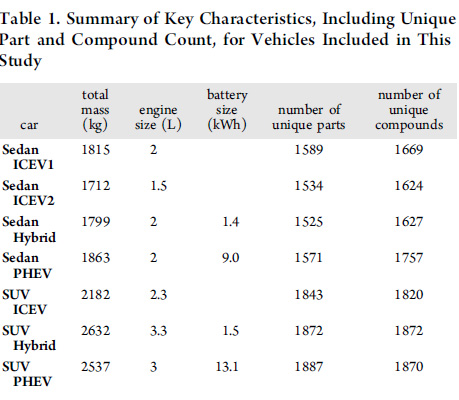
After some review of various approaches to identifying the elements, including, for example, analysis of shredded cars, the author chose to do their analysis by studying a data set of over 350,000 parts comprising 2019 and 2020 Ford vehicles, and then queried an international database, International Materials Data System (IMDS), a platform utilized by over 100,000 suppliers, as well as the Chemical Abstracts Service (CAS).
(The authors are at MIT and at the Ford Motor Company, the latter set surely having access to sophisticated specifications of parts.)
Obviously this approach cannot be comprehensive, and the authors give a feel cases fairly certain vs. those that involve estimates in this figure from the paper:
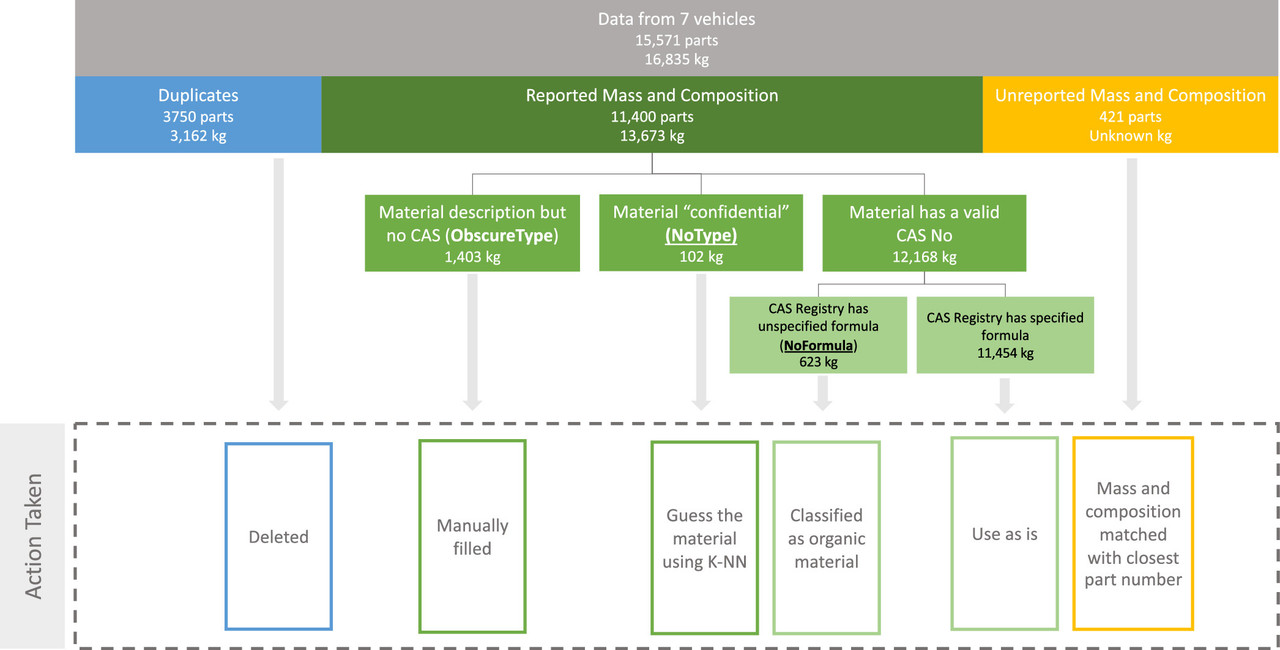
The caption:
The authors eliminated duplicates reflecting cases where parts had more than one supplier.
For me, the following graphic is the "money shot," a breakdown of elements present in quantities greater than one gram.
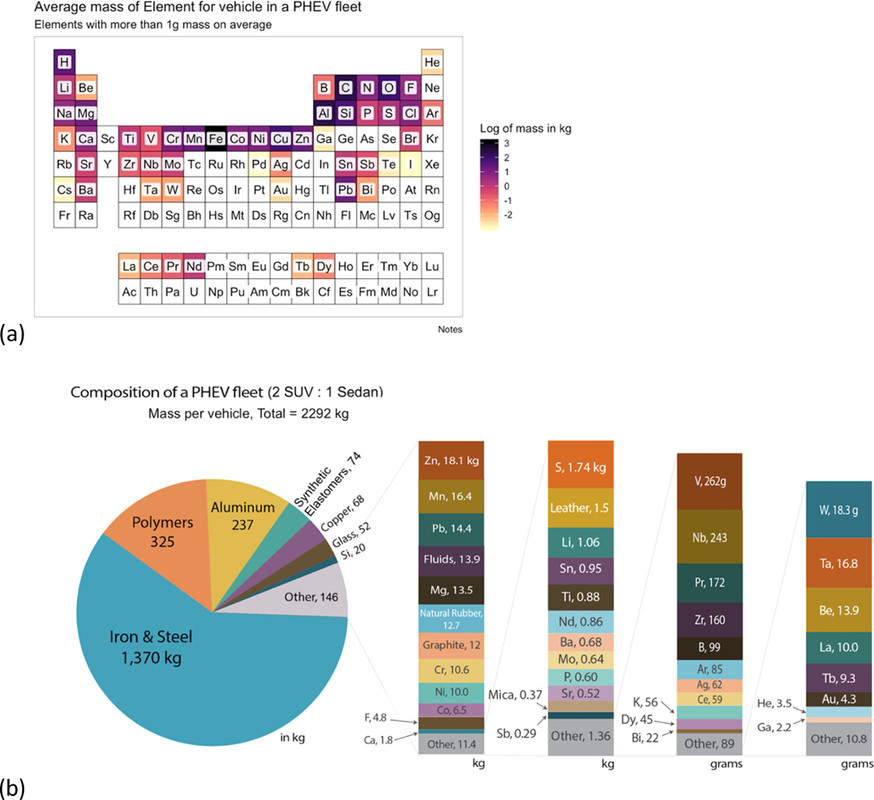
The caption:
I'm somewhat surprised with the absence of ruthenium, rhodium, palladium or platinum in quantities greater than 1 gram. All of these elements used widely in catalytic converters, typically in gram quantities coated onto highly pleated or porous supports, since a PHEV does contain a gasoline fueled engine as a component. I'm sure there's an explanation for that with these Ford vehicles.
For now, however, I'd like to focus on the 6.5 kg of cobalt in a plug-in hybrid, an amount which is surely greater in a purely electric car.
The USGS estimates that the world reserves of cobalt are about 7 million tons, dominated by supplies in the "Democratic Republic of Congo," DRC, where cobalt is mined under conditions that are generally in total disregard of basic human rights, conditions of near or actual human slavery. The DRC is said to have reserves of 3,600,000 million tons, followed by Australia, which is said to have reserves of 1.2 million tons, then Cuba, with 500,000 tons. The 6.5 kg per car suggests that there would thus be enough cobalt to produce a little over one billion plugin hybrid cars under the condition that we used all the world's cobalt reserves for nothing else. Brief googling suggests that the world car fleet seems to be somewhere around 1 to 1.4 billion cars.
The problem is that even if we could dig all this cobalt up, and refine it and put it into batteries for plug in hybrid cars, is that there are lots of other batteries on the planet which are not dedicated to hybrid plugin electric cars. In fact, some people, not me certainly, advocate supplying the power grid with batteries in order to address the extreme variability and need for redundancy experimentally observed to be implicit in the widely applauded movement to so called "renewable energy" even though this movement has done exactly zero to address climate change, which is getting worse, faster than ever before, in spite of half a century or cheering for this reactionary fantasy. Then there's computer batteries, lighting batteries, emergency batteries, etc., etc., ad infinitium.
Also cobalt is a very important constituent of important alloys featuring high strength and temperature and corrosion resistance. They are utilized in areas as various as the aerospace industry to medical and dental implants.
One fantasy or another has to give just from the pure physical reserves of cobalt.
Of course, as we use up the cobalt, this will have some effect on the price of the metal would it not?
This is the focus of the paper, the financial implications of the limits of supply. The authors suggest a formula for (price) susceptibility in this text reproduced here as a graphics object to allow for the equation to be clear:
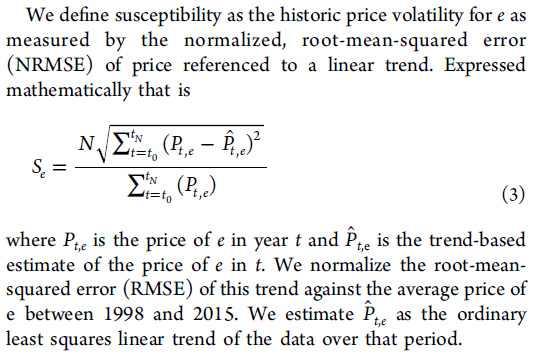
They continue:
The following graphic gives reference to the materials price sensitivity to produce one million cars:
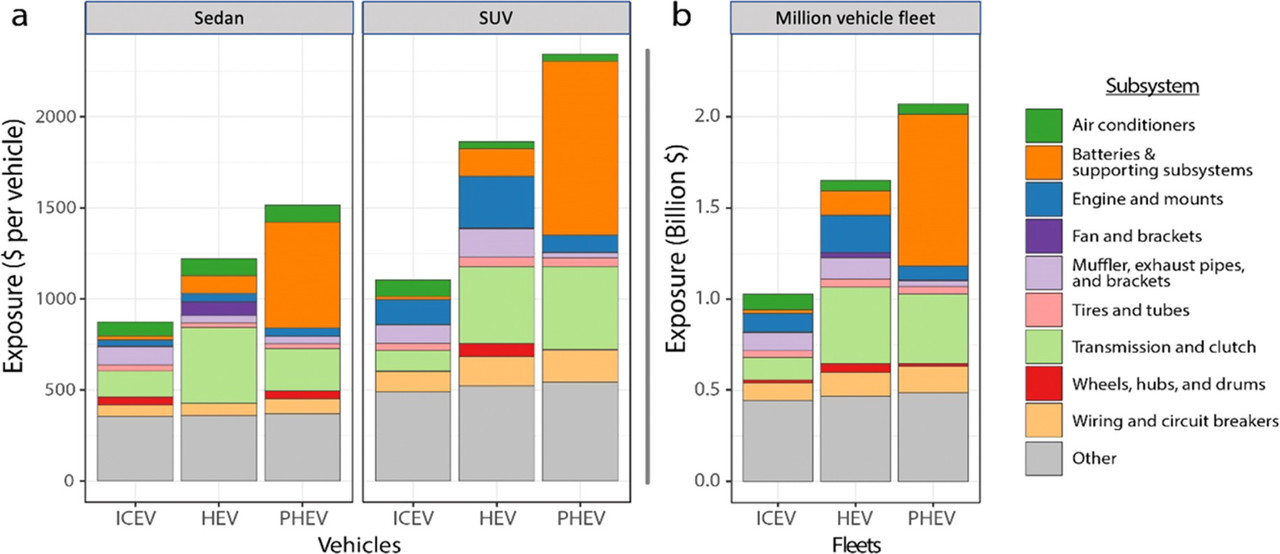
The caption:
To discuss the price variability connected with replacing all the world's cars with plugin hybrids, not that this is remotely possible, we need to multiply these numbers by 1000, suggesting that replacing the world's cars with plugin hybrids would face a supply risk of 2 trillion dollars, compared with replacement with internal combustion vehicles of one trillion dollars, a trillion more.
A comparison of the top 20 elements driving supply risks:
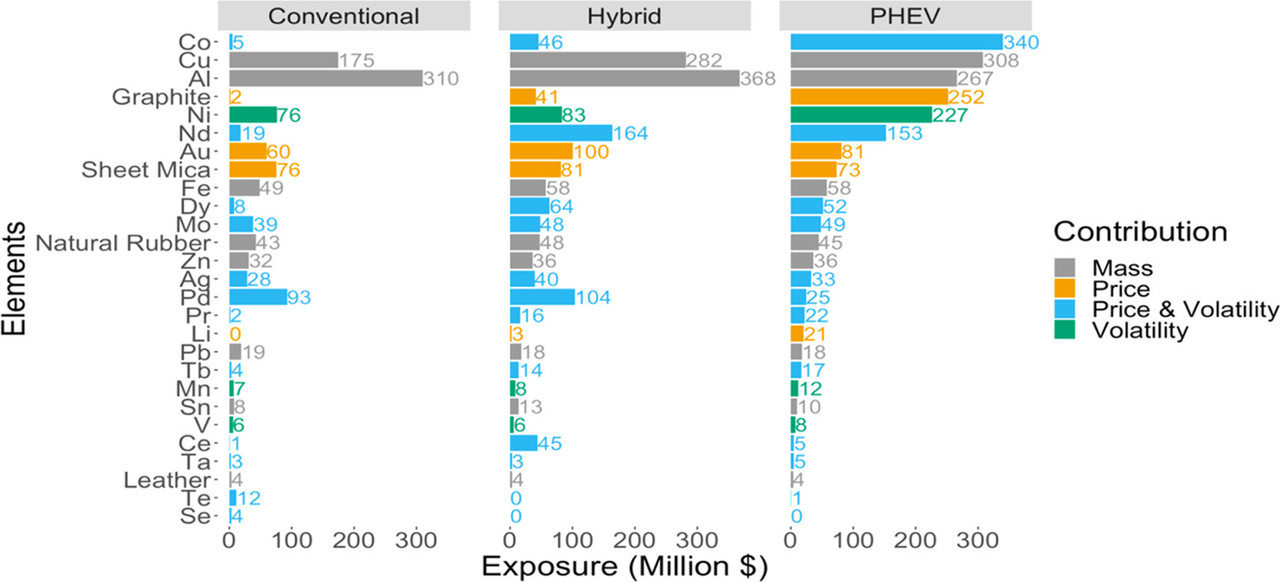
The caption:
Remarking on this figure the authors write:
Another big hand-waving supposition in the obviously failing (unless one thinks climate change isn't getting worse faster) "renewables with batteries will save us" fantasy is that the materials in batteries are easily recyclable. In theory, but seldom, if ever, in practice, everything is recyclable given enough energy, but the problem is then translated into energy, and no solar cells, wind turbines and batteries will not produce enough energy to recycle solar cells, wind turbines and batteries, while addressing everything else; the energy density is far too low.
The authors, somewhat more sophisticated than handwaving types on "let's all cheer" websites, have these comments on recycling:
They still suggest looking for ways to substitute for cobalt, aluminum, copper, graphite, nickel, and neodymium, while confessing plainly that the drive for car electrification will continue to drive up the costs of these limited resources.
I have argued many times that the car CULTure is not sustainable in any form, that there is no such thing as a "green car," even though there is a whole pop website about "green cars," which once gave an award to the Audi A3 TDI before it was learned that the "green" depended on defeat devices in the software to conceal true emissions.
I see no reason to change my views on the car CULTure. I am a participant in it, but the reality is I know I am doing wrong in so being.
I do believe it possible - I hope - to build a sustainable world that can provide some self propelled vehicles, for example tractors, construction vehicles, local transport delivery and emergency vehicles. It is clear to me that the best path to providing these will rely on liquid fuels or liquified gases, the best of these being DME, dimethyl ether, which can be obtained by the hydrogenation of carbon dioxide, with the captive use hydrogen, an energy intermediate, being provided by thermochemical means, also affording oxygen to simply to recovery of carbon dioxide from the atmosphere.
I point to this excellent remark about "carbon's little buddy," which came up in another post of mine here about the periodic table:
Hydrogen (disparaged as "Carbon's little buddy" does the heavy lifting.
Periodic Table As Seen By Organic Chemists.
Have a nice evening.